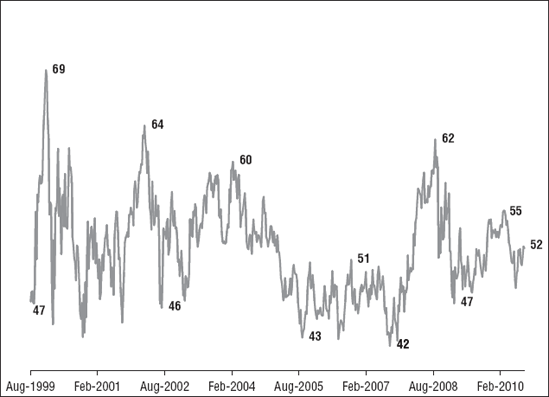Chapter 2. A Sideways View of the World
What Happens in a Sideways Market
Most people (myself included) find discussions about stock markets a bit esoteric; for us, it is a lot easier to relate to individual stocks. Since a stock market is just a collection of individual stocks, let's take a look at a very typical sideways stock first: Wal-Mart. It will give us insight into what takes place in a sideways market (see Exhibit 2.1). Though its shareholders experienced plenty of volatility over the past 10 years, the stock has gone nowhere—it fell prey to a cowardly lion.

Figure 2.1. Wal-Mart Typical Sideways Market Stock
Over the last decade Wal-Mart's earnings almost tripled from $1.25 per share to $3.42, growing at an impressive rate of 11.8 percent a year. This doesn't look like a stagnant, failing company; in fact, it's quite an impressive performance for a company whose sales are approaching half a trillion dollars. However, its stock chart led you to believe otherwise. The culprit responsible for this unexciting performance was valuation—the P/E—which declined from 45 to 13.7, or about 12.4 percent a year. The stock has not gone anywhere, as all the benefits from earnings growth were canceled out by a declining P/E. Even though revenues more than doubled and earnings almost tripled, all of the return for shareholders of this terrific company came from dividends, which did not amount ...
Get The Little Book of Sideways Markets: How to Make Money in Markets that Go Nowhere now with the O’Reilly learning platform.
O’Reilly members experience books, live events, courses curated by job role, and more from O’Reilly and nearly 200 top publishers.

